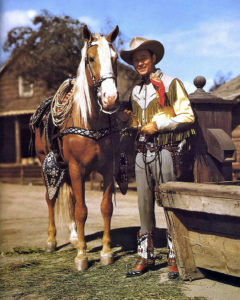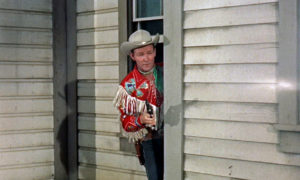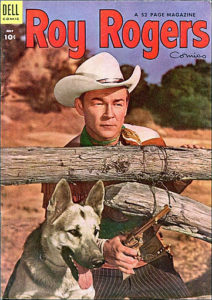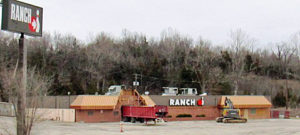It turns out that the late Roy Rogers, “The King of the Cowboys,” had a link to Kansas City, Kansas. My coverage of that tie-in was originally published in The Kansas City Kansan (Crum on Film) on Aug. 25, 2000. Since then, the Rogers museum in Victorville, California has closed…as has his transplanted museum in Branson, Missouri.
 By Steve Crum
By Steve Crum
The legend of Roy Rogers continues. The two years following this great singing cowboy’s death have only positively affected the heartfelt wholesome, All-American persona of the man who will forever be King of the Cowboys. Fans of Roy Rogers—like yours truly—are fans for life. Thanks to TV and movies, and especially the video copies thereof, he will forever live.
The Cincinnati boy who was born Leonard Franklin Slye became a heroic icon during the early 1940s when the then Republic Pictures top cowboy star Gene Autry left the studio for armed forces service in World War II. A name change from Slye to Dick Weston was soon replaced with Roy Rogers, and a new king was in the saddle. That was a few years before he rode off into the sunset to Kansas City, Kansas. Sorry pards, ah’m gittin’ ahead of myself.
 From 1935-98, Roy Rogers made 116 movies, which is staggering even realizing many of the “features” he made at Republic average 60 minutes in length. Then there was The Roy Rogers Show on TV in the early 1950s, after Republic had folded. Let us not forget his terrific co-starring role with Bob Hope in 1952’s Son of Paleface. Seven years later was that Hope comedy-western in which Roy made a memorable cameo appearance, Alias Jesse James. His scene is toward the end when he appears out of nowhere to help star Hope’s character fight the bad guys. Rogers levels his pistol at a varmint about to shoot Hope. He fires and connects, commenting, “And happy trails to you!” It is a perfect zinger from the hero of heroes.
From 1935-98, Roy Rogers made 116 movies, which is staggering even realizing many of the “features” he made at Republic average 60 minutes in length. Then there was The Roy Rogers Show on TV in the early 1950s, after Republic had folded. Let us not forget his terrific co-starring role with Bob Hope in 1952’s Son of Paleface. Seven years later was that Hope comedy-western in which Roy made a memorable cameo appearance, Alias Jesse James. His scene is toward the end when he appears out of nowhere to help star Hope’s character fight the bad guys. Rogers levels his pistol at a varmint about to shoot Hope. He fires and connects, commenting, “And happy trails to you!” It is a perfect zinger from the hero of heroes.
 About the time Alias Jesse James was released, Roy Rogers moseyed into Kansas City, Kansas. He and his entourage were appearing somewhere in Greater Kansas City—undoubtedly singing (exact details unknown)—and staying at the gone-but-never-forgotten Town House Hotel in downtown KCK. It was then, in the late afternoon, that Jackie Heffley got a phone call. She and her late husband Rex ran the Ranch Bowl (bowling alley, that is) at 5604 State Ave.
About the time Alias Jesse James was released, Roy Rogers moseyed into Kansas City, Kansas. He and his entourage were appearing somewhere in Greater Kansas City—undoubtedly singing (exact details unknown)—and staying at the gone-but-never-forgotten Town House Hotel in downtown KCK. It was then, in the late afternoon, that Jackie Heffley got a phone call. She and her late husband Rex ran the Ranch Bowl (bowling alley, that is) at 5604 State Ave.
“One of Roy’s men called, telling me that Roy and and his friends were wanting to rent the bowling alley after midnight.” She does not remember the exact date, but does recall that the voice said that Roy wanted to “unwind by bowling,” and would privately bowl for a couple of hours. The Heffleys were stunned, but immediately agreed to the arrangements.
“Roy and 67 other men came down and bowled a couple of hours,” Jackie said. “The had a good time.”
Was Roy Rogers a good bowler? Jackie said that she really does not know how he bowled that early morning. She just gave him the privacy he desired, treating him like any other bowling customer. “He was a very congenial,  earthy person.”
earthy person.”
Autographs or pictures with Roy? “No, we didn’t even think of pictures at all,” she said. “But he did autograph two plastic bowling pin banks we had there.” Did he bring his own bowling shoes? “Yes.” (I refrained from asking if his shoes had spurs.) Was Trigger or Dale Evans with him? “No.”
Jackie said that years later she realized just how much important bowling was to Rogers when she and her family toured his Roy Rogers Museum in Victorville, California. “There is an entire section devoted to Roy’s bowling trophies, team pictures and awards. He was a huge bowling fan, and was for years a Victorville Bowling Team member.
 (UPDATE: The very aptly named Ranch Bowl was demolished in 2018. See photo.)
(UPDATE: The very aptly named Ranch Bowl was demolished in 2018. See photo.)
So the legend continues, and a King of the Keglers emerges. Happy strikes to you until we bowl again.
Yeah, I know—spare me.
